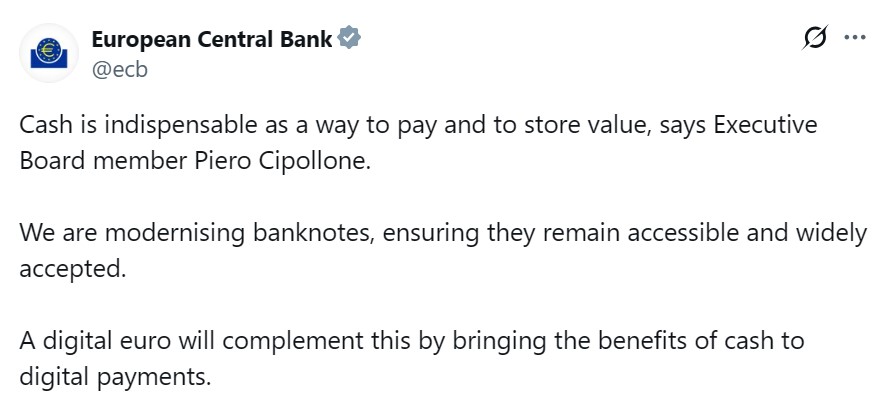The European Central Bank confirms the digital euro will complement physical cash, preserving payment autonomy and ensuring legal tender status for both forms in Europe’s financial system.
-
The digital euro is designed to coexist with banknotes and coins, not replace them, supporting diverse payment preferences.
-
The ECB aims to counter stablecoin dominance by providing a regulated, state-backed digital currency alternative.
-
ECB studies show limited current interest in the digital euro, highlighting the ongoing importance of cash.
Digital euro complements physical cash to secure Europe’s payment autonomy amid stablecoin growth. Learn how the ECB balances innovation and tradition.
How Will the Digital Euro Complement Physical Cash?
The digital euro is intended to supplement euro banknotes and coins, ensuring payment autonomy and legal tender status across Europe. ECB Executive Board member Piero Cipollone emphasized that cash availability in both physical and electronic forms will strengthen the financial ecosystem. This dual approach caters to diverse consumer preferences and maintains resilience during digital infrastructure disruptions.
Why Does the ECB Insist Cash Remains Indispensable?
The ECB recognizes cash’s critical role, especially in crises when digital systems may fail. Cipollone stated, “Cash is here to stay,” highlighting that euro area consumers will benefit from having physical and digital euros accessible anytime. This ensures inclusive payment options for all demographics, preserving trust in the monetary system.

Source: European Central Bank
What Drives the ECB’s Push for a Digital Euro?
The ECB is advancing the digital euro to provide a regulated alternative to privately issued stablecoins, which are increasingly used for cross-border payments and everyday transactions. Cipollone warned that without a digital euro, foreign stablecoins could dominate Europe’s payment landscape, posing risks and missed opportunities for the central bank.
How Does the Digital Euro Address Stablecoin Challenges?
By offering a state-backed digital currency, the ECB aims to limit the influence of dollar-pegged stablecoins and enhance monetary sovereignty. ECB adviser Jürgen Schaaf advocates for global coordination on stablecoin regulation, emphasizing the EU’s strategic options, including euro-pegged stablecoins, distributed ledger technology applications, and the digital euro itself.
| Payment Method | Current Usage | Future Outlook |
|---|---|---|
| Physical Cash | Widely used, especially in crises | Continues as legal tender alongside digital euro |
| Digital Euro | Limited current adoption | Expected to grow as regulated alternative to stablecoins |
| Stablecoins | Increasing use in cross-border payments | Regulatory scrutiny and competition from digital euro |
What Do ECB Studies Reveal About Public Interest in the Digital Euro?
Research from March 2025 indicates Europeans currently show limited enthusiasm for the digital euro. When asked to allocate €10,000 across assets, participants assigned only a small portion to the digital euro, with minimal impact on traditional cash holdings. This underscores the enduring trust and preference for physical money despite digital innovation.
How Might Consumer Preferences Shape the Digital Euro’s Adoption?
Consumers value accessibility and legal tender status in all payment forms. The ECB plans to tailor the digital euro to diverse scenarios, ensuring it complements existing cash usage rather than replacing it. This inclusive strategy aims to foster gradual adoption while maintaining financial stability.
Frequently Asked Questions
Will the digital euro replace cash in Europe?
The digital euro is designed to complement, not replace, physical cash. Both will retain legal tender status, ensuring consumers have flexible payment options.
How does the ECB plan to compete with stablecoins?
The ECB is developing the digital euro as a regulated, state-backed alternative to privately issued stablecoins, aiming to maintain Europe’s payment sovereignty.
Key Takeaways
- Digital euro complements cash: It will coexist with banknotes and coins to preserve payment autonomy.
- Stablecoin regulation: The ECB seeks to limit stablecoin dominance through a regulated digital currency.
- Consumer preference: Cash remains essential, especially during crises, with digital euro adoption expected to grow gradually.
Conclusion
The ECB’s digital euro initiative reflects a balanced approach to innovation and tradition, ensuring physical cash and digital currency coexist to safeguard Europe’s payment autonomy. As stablecoins rise, the digital euro offers a secure, regulated alternative, reinforcing trust in the financial system while catering to evolving consumer needs.
